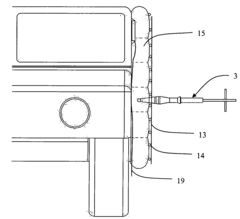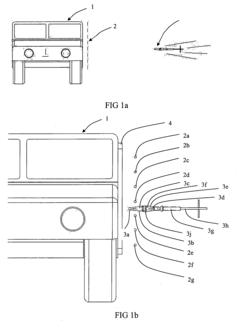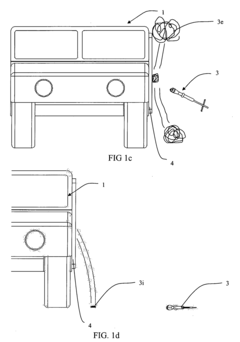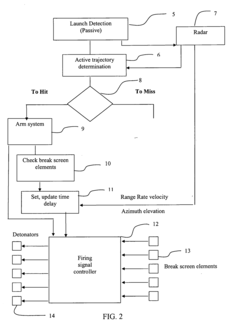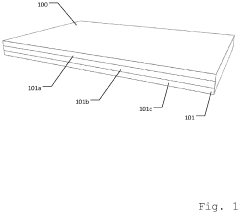Kevlar’s Role in Advancing Military Vehicle Armor
JUL 10, 20259 MIN READ
Generate Your Research Report Instantly with AI Agent
Patsnap Eureka helps you evaluate technical feasibility & market potential.
Kevlar Evolution in Military Armor
Kevlar's evolution in military armor represents a significant advancement in protective technology for military vehicles. Initially developed by DuPont in the 1960s, Kevlar quickly found applications in military and law enforcement due to its exceptional strength-to-weight ratio and heat-resistant properties.
The early adoption of Kevlar in military vehicle armor began in the 1970s, primarily as a lightweight alternative to traditional steel plating. Its initial use was limited to specific areas of vehicles where weight reduction was crucial, such as in aircraft and light armored vehicles. The material's ability to absorb and dissipate energy from impacts made it particularly effective against small arms fire and shrapnel.
As manufacturing techniques improved in the 1980s and 1990s, Kevlar's integration into military vehicle armor became more sophisticated. Layered composite armor systems were developed, combining Kevlar with other materials like ceramics and high-density polyethylene. These multi-layer systems provided enhanced protection against a wider range of threats while maintaining a relatively low weight profile.
The turn of the millennium saw a significant leap in Kevlar's application in military armor. Advanced weaving techniques and the development of Kevlar-based composites led to the creation of more flexible and adaptable armor solutions. This allowed for better coverage of complex vehicle geometries and improved overall protection without compromising mobility.
In recent years, the focus has shifted towards integrating Kevlar into modular armor systems. These systems allow for quick replacement of damaged sections and easy upgrades as new threats emerge. Additionally, researchers have been exploring ways to enhance Kevlar's properties through nanotechnology, potentially leading to even stronger and lighter armor solutions.
The latest developments in Kevlar-based military vehicle armor include its incorporation into active protection systems. These systems combine Kevlar's passive protection capabilities with sensors and countermeasures to detect and neutralize incoming threats before they impact the vehicle. This integration represents a significant step forward in comprehensive vehicle protection strategies.
Throughout its evolution, Kevlar has consistently demonstrated its value in military vehicle armor. Its continuous improvement and adaptation to new threats have made it an indispensable component in modern military vehicle protection systems, significantly enhancing the survivability of personnel and equipment in combat situations.
The early adoption of Kevlar in military vehicle armor began in the 1970s, primarily as a lightweight alternative to traditional steel plating. Its initial use was limited to specific areas of vehicles where weight reduction was crucial, such as in aircraft and light armored vehicles. The material's ability to absorb and dissipate energy from impacts made it particularly effective against small arms fire and shrapnel.
As manufacturing techniques improved in the 1980s and 1990s, Kevlar's integration into military vehicle armor became more sophisticated. Layered composite armor systems were developed, combining Kevlar with other materials like ceramics and high-density polyethylene. These multi-layer systems provided enhanced protection against a wider range of threats while maintaining a relatively low weight profile.
The turn of the millennium saw a significant leap in Kevlar's application in military armor. Advanced weaving techniques and the development of Kevlar-based composites led to the creation of more flexible and adaptable armor solutions. This allowed for better coverage of complex vehicle geometries and improved overall protection without compromising mobility.
In recent years, the focus has shifted towards integrating Kevlar into modular armor systems. These systems allow for quick replacement of damaged sections and easy upgrades as new threats emerge. Additionally, researchers have been exploring ways to enhance Kevlar's properties through nanotechnology, potentially leading to even stronger and lighter armor solutions.
The latest developments in Kevlar-based military vehicle armor include its incorporation into active protection systems. These systems combine Kevlar's passive protection capabilities with sensors and countermeasures to detect and neutralize incoming threats before they impact the vehicle. This integration represents a significant step forward in comprehensive vehicle protection strategies.
Throughout its evolution, Kevlar has consistently demonstrated its value in military vehicle armor. Its continuous improvement and adaptation to new threats have made it an indispensable component in modern military vehicle protection systems, significantly enhancing the survivability of personnel and equipment in combat situations.
Armor Market Demand Analysis
The global market for military vehicle armor has been experiencing steady growth, driven by increasing defense budgets, ongoing regional conflicts, and the need for enhanced protection against evolving threats. The demand for advanced armor solutions, particularly those incorporating Kevlar, has seen a significant uptick in recent years.
Kevlar, a high-strength synthetic fiber developed by DuPont, has become a crucial component in modern military vehicle armor systems. Its exceptional strength-to-weight ratio and ability to absorb impact energy make it an ideal material for enhancing protection without significantly increasing vehicle weight. This characteristic is particularly valuable as military forces seek to balance mobility with protection.
The market for Kevlar-based armor solutions is primarily driven by the need to protect military personnel from a wide range of threats, including small arms fire, improvised explosive devices (IEDs), and shrapnel. As asymmetric warfare and urban combat scenarios become more prevalent, the demand for lightweight yet effective armor solutions has intensified.
Several key factors are influencing the market demand for Kevlar-enhanced military vehicle armor. First, there is a growing emphasis on soldier survivability, with many nations prioritizing investments in advanced protection systems. Second, the increasing use of unmanned ground vehicles (UGVs) in military operations has created a new segment of the market that requires specialized armor solutions to protect valuable equipment and sensors.
The automotive armor market, which includes military vehicles, is projected to grow at a compound annual growth rate (CAGR) of over 5% in the coming years. This growth is partly attributed to the integration of advanced materials like Kevlar into armor designs. The Asia-Pacific region is expected to witness the highest growth rate, driven by increasing defense spending in countries like India and China.
Furthermore, there is a rising trend towards the development of multi-layered armor systems that combine Kevlar with other materials such as ceramics and high-strength steels. This approach aims to provide comprehensive protection against a broader spectrum of threats while optimizing weight and cost considerations.
The market is also seeing increased demand for modular armor solutions that can be easily upgraded or replaced in the field. This trend aligns with the military's need for adaptable protection systems that can be quickly modified to address specific mission requirements or emerging threats.
As environmental concerns gain prominence, there is growing interest in sustainable and recyclable armor materials. This presents both a challenge and an opportunity for Kevlar-based solutions, as manufacturers explore ways to enhance the material's eco-friendly properties while maintaining its protective capabilities.
Kevlar, a high-strength synthetic fiber developed by DuPont, has become a crucial component in modern military vehicle armor systems. Its exceptional strength-to-weight ratio and ability to absorb impact energy make it an ideal material for enhancing protection without significantly increasing vehicle weight. This characteristic is particularly valuable as military forces seek to balance mobility with protection.
The market for Kevlar-based armor solutions is primarily driven by the need to protect military personnel from a wide range of threats, including small arms fire, improvised explosive devices (IEDs), and shrapnel. As asymmetric warfare and urban combat scenarios become more prevalent, the demand for lightweight yet effective armor solutions has intensified.
Several key factors are influencing the market demand for Kevlar-enhanced military vehicle armor. First, there is a growing emphasis on soldier survivability, with many nations prioritizing investments in advanced protection systems. Second, the increasing use of unmanned ground vehicles (UGVs) in military operations has created a new segment of the market that requires specialized armor solutions to protect valuable equipment and sensors.
The automotive armor market, which includes military vehicles, is projected to grow at a compound annual growth rate (CAGR) of over 5% in the coming years. This growth is partly attributed to the integration of advanced materials like Kevlar into armor designs. The Asia-Pacific region is expected to witness the highest growth rate, driven by increasing defense spending in countries like India and China.
Furthermore, there is a rising trend towards the development of multi-layered armor systems that combine Kevlar with other materials such as ceramics and high-strength steels. This approach aims to provide comprehensive protection against a broader spectrum of threats while optimizing weight and cost considerations.
The market is also seeing increased demand for modular armor solutions that can be easily upgraded or replaced in the field. This trend aligns with the military's need for adaptable protection systems that can be quickly modified to address specific mission requirements or emerging threats.
As environmental concerns gain prominence, there is growing interest in sustainable and recyclable armor materials. This presents both a challenge and an opportunity for Kevlar-based solutions, as manufacturers explore ways to enhance the material's eco-friendly properties while maintaining its protective capabilities.
Current Kevlar Armor Challenges
Despite the significant advancements in Kevlar armor technology for military vehicles, several challenges persist in its application and effectiveness. One of the primary concerns is the trade-off between protection and mobility. While Kevlar offers excellent ballistic protection, increasing its thickness to counter more powerful threats can lead to substantial weight gain, potentially compromising vehicle maneuverability and fuel efficiency.
Another challenge lies in the limited protection Kevlar provides against certain types of threats. While highly effective against small arms fire and shrapnel, Kevlar armor struggles to defend against high-caliber rounds, armor-piercing ammunition, and shaped charges. This vulnerability necessitates the integration of additional armor materials, further complicating design and manufacturing processes.
The durability of Kevlar armor in extreme environmental conditions remains a concern. Prolonged exposure to intense heat, humidity, and UV radiation can degrade the material's performance over time. This degradation may not be immediately apparent, leading to potential vulnerabilities in the field. Additionally, the impact of chemical warfare agents on Kevlar's long-term effectiveness is an area requiring further research and development.
Cost-effectiveness presents another significant challenge. While Kevlar is lighter than traditional steel armor, it is considerably more expensive. This high cost can limit its widespread adoption, particularly for larger vehicles or in situations where frequent replacement is necessary due to damage or wear.
The manufacturing process of Kevlar armor for military vehicles also poses challenges. Ensuring consistent quality across large production runs, especially for complex vehicle geometries, requires advanced manufacturing techniques and rigorous quality control measures. The integration of Kevlar with other materials to create composite armor systems further complicates the production process.
Lastly, the evolving nature of battlefield threats necessitates continuous innovation in Kevlar armor technology. As adversaries develop more sophisticated weapons and tactics, the armor must adapt rapidly. This constant need for improvement strains research and development resources and challenges manufacturers to quickly implement new designs without compromising reliability or increasing costs prohibitively.
Another challenge lies in the limited protection Kevlar provides against certain types of threats. While highly effective against small arms fire and shrapnel, Kevlar armor struggles to defend against high-caliber rounds, armor-piercing ammunition, and shaped charges. This vulnerability necessitates the integration of additional armor materials, further complicating design and manufacturing processes.
The durability of Kevlar armor in extreme environmental conditions remains a concern. Prolonged exposure to intense heat, humidity, and UV radiation can degrade the material's performance over time. This degradation may not be immediately apparent, leading to potential vulnerabilities in the field. Additionally, the impact of chemical warfare agents on Kevlar's long-term effectiveness is an area requiring further research and development.
Cost-effectiveness presents another significant challenge. While Kevlar is lighter than traditional steel armor, it is considerably more expensive. This high cost can limit its widespread adoption, particularly for larger vehicles or in situations where frequent replacement is necessary due to damage or wear.
The manufacturing process of Kevlar armor for military vehicles also poses challenges. Ensuring consistent quality across large production runs, especially for complex vehicle geometries, requires advanced manufacturing techniques and rigorous quality control measures. The integration of Kevlar with other materials to create composite armor systems further complicates the production process.
Lastly, the evolving nature of battlefield threats necessitates continuous innovation in Kevlar armor technology. As adversaries develop more sophisticated weapons and tactics, the armor must adapt rapidly. This constant need for improvement strains research and development resources and challenges manufacturers to quickly implement new designs without compromising reliability or increasing costs prohibitively.
Existing Kevlar Armor Solutions
01 Kevlar-based armor composition
Armor compositions incorporating Kevlar fibers for enhanced protection. These compositions may include multiple layers of Kevlar fabric or combine Kevlar with other materials to improve ballistic resistance and overall protective capabilities.- Kevlar-based armor composition: Armor compositions incorporating Kevlar fibers for enhanced protection. These compositions may include multiple layers of Kevlar fabric or combine Kevlar with other materials to improve ballistic resistance and overall protective capabilities.
- Kevlar armor for personal protection: Personal protective equipment utilizing Kevlar for body armor, including vests, helmets, and other wearable protective gear. These designs focus on lightweight, flexible solutions that offer high-level protection for military, law enforcement, and civilian applications.
- Kevlar-reinforced vehicle armor: Armor systems for vehicles incorporating Kevlar materials to enhance protection against ballistic threats. These systems may include modular designs, composite structures, or integrated Kevlar panels to improve vehicle survivability in combat situations.
- Kevlar-based protective clothing: Protective clothing and garments incorporating Kevlar fibers for various applications, including industrial safety, firefighting, and extreme sports. These garments offer improved cut resistance, heat protection, and durability while maintaining comfort and flexibility.
- Kevlar composite armor systems: Advanced armor systems combining Kevlar with other materials such as ceramics, metals, or advanced polymers to create multi-layered protective structures. These composite systems aim to maximize protection while minimizing weight and thickness for various applications.
02 Lightweight and flexible Kevlar armor designs
Innovative designs focusing on creating lightweight and flexible Kevlar armor solutions. These designs aim to provide maximum protection while maintaining mobility and comfort for the wearer, suitable for various applications including personal protection and vehicle armor.Expand Specific Solutions03 Kevlar armor with enhanced impact resistance
Armor systems incorporating Kevlar that are specifically designed to improve impact resistance. These systems may include additional layers or treatments to absorb and disperse energy from impacts, enhancing overall protection against various threats.Expand Specific Solutions04 Multi-functional Kevlar armor
Kevlar armor solutions that offer multiple protective functions beyond ballistic resistance. These may include features such as fire resistance, chemical protection, or integrated communication systems, providing comprehensive protection for various scenarios.Expand Specific Solutions05 Kevlar armor manufacturing techniques
Advanced manufacturing techniques for producing Kevlar armor, including innovative weaving methods, layering processes, and integration with other materials. These techniques aim to optimize the protective properties of Kevlar while improving production efficiency and reducing costs.Expand Specific Solutions
Key Kevlar Armor Manufacturers
The competitive landscape for Kevlar's role in advancing military vehicle armor is characterized by a mature market with established players and ongoing innovation. The global military vehicle armor market is substantial, estimated to be worth several billion dollars annually, with steady growth projected. Technologically, the field is well-developed but continues to evolve, driven by the need for lighter, stronger, and more cost-effective protection. Key players like BAE Systems, Rheinmetall Landsysteme, and Textron Systems are at the forefront, leveraging their extensive experience in defense technologies. Research institutions such as MIT and the Naval Research Laboratory contribute to advancements, while companies like RMA Armament focus on specialized armor solutions. The industry sees collaboration between government agencies, academic institutions, and private sector firms to push the boundaries of armor technology.
RMA Armament, Inc.
Technical Solution: RMA Armament has developed advanced Kevlar-based armor solutions for military vehicles. Their approach involves multi-layered composite panels that incorporate Kevlar fibers with ceramic and polyethylene materials. This combination provides enhanced protection against ballistic threats while maintaining a relatively lightweight structure. The company's proprietary manufacturing process allows for precise control of fiber orientation and resin distribution, resulting in armor plates with superior strength-to-weight ratios[1]. RMA's Kevlar-enhanced vehicle armor has demonstrated improved resistance to fragmentation and spalling, crucial for protecting personnel inside military vehicles[2].
Strengths: Excellent ballistic protection, lightweight design, and improved personnel safety. Weaknesses: Potentially higher production costs and complexity in manufacturing process.
Rheinmetall Landsysteme GmbH
Technical Solution: Rheinmetall has integrated Kevlar into their advanced modular armor systems for military vehicles. Their approach combines Kevlar with other materials like high-hardness steels and ceramics in a layered structure. This composite armor is designed to defeat multiple threat levels, from small arms fire to explosively formed penetrators. Rheinmetall's Kevlar-enhanced armor panels can be easily attached or removed, allowing for rapid reconfiguration of vehicle protection based on mission requirements[3]. The company has also developed Kevlar-based spall liners that significantly reduce the risk of secondary projectiles inside the vehicle cabin upon impact[4].
Strengths: Modular design for mission flexibility, comprehensive protection against various threats. Weaknesses: Potential increase in overall vehicle weight, higher costs for full vehicle coverage.
Kevlar Armor Patent Analysis
Explosive round countermeasure system
PatentActiveUS20090266226A1
Innovation
- A sensor-controlled, inflatable ballistic penetration resistant airbag system with an explosive array or defusing net that collapses the ogive of an incoming RPG to disable the fusing mechanism, incorporating a gas generator for inflation and a processing system to detect and confirm the RPG's motion, deploying a barrier screen to short the ogive nose and absorb the RPG's kinetic energy.
Laminate Structure Comprising a Nanoparticle Quasi-Thermoset Polymer
PatentInactiveUS20190346237A1
Innovation
- A laminated structure incorporating a carbon nanoparticle thermoplastic elastomer layer made of ultra-high modulus, super elastic shape memory thermoplastic polyurethane with UV stabilizers and siloxane process aids between substrates to disperse energy and increase tear strength, reducing back-face deformation and trauma from projectile impacts.
Kevlar Armor Testing Standards
Kevlar armor testing standards play a crucial role in ensuring the effectiveness and reliability of military vehicle armor systems. These standards encompass a comprehensive set of protocols and procedures designed to evaluate the performance of Kevlar-based armor under various conditions and threats.
The primary focus of these testing standards is to assess the armor's ability to withstand ballistic impacts. This involves subjecting Kevlar armor panels to a range of projectiles, including small arms fire, shrapnel, and explosive fragments. The tests are conducted using standardized firing ranges and equipment to ensure consistency and reproducibility of results.
One key aspect of Kevlar armor testing is the measurement of ballistic limit velocity (V50). This metric represents the velocity at which 50% of projectiles are expected to penetrate the armor. V50 testing involves firing multiple rounds at varying velocities to determine the armor's protective capabilities accurately.
In addition to ballistic resistance, Kevlar armor testing standards also evaluate other critical factors. These include the armor's resistance to environmental conditions such as extreme temperatures, humidity, and chemical exposure. Durability tests assess the armor's ability to withstand repeated impacts and maintain its protective properties over time.
Weight and flexibility are also important considerations in Kevlar armor testing. Standards often include measurements of areal density (weight per unit area) and flexibility tests to ensure that the armor provides adequate protection without compromising mobility or causing undue fatigue to vehicle occupants.
Multi-hit performance is another crucial aspect of Kevlar armor testing. This involves assessing the armor's ability to withstand multiple impacts in close proximity, simulating real-world combat scenarios where vehicles may be subjected to sustained fire.
Kevlar armor testing standards also incorporate non-destructive evaluation techniques. These may include ultrasonic testing, X-ray imaging, and thermography to detect any internal defects or delamination within the armor panels that could compromise their protective capabilities.
Standardized reporting and documentation procedures are an integral part of Kevlar armor testing. These ensure that test results are recorded accurately and can be compared across different testing facilities and armor manufacturers. This standardization is essential for maintaining quality control and facilitating continuous improvement in armor design and production.
As threats evolve, Kevlar armor testing standards are regularly reviewed and updated to address new challenges. This ongoing process involves collaboration between military organizations, research institutions, and industry partners to develop more sophisticated testing methodologies and performance criteria.
The primary focus of these testing standards is to assess the armor's ability to withstand ballistic impacts. This involves subjecting Kevlar armor panels to a range of projectiles, including small arms fire, shrapnel, and explosive fragments. The tests are conducted using standardized firing ranges and equipment to ensure consistency and reproducibility of results.
One key aspect of Kevlar armor testing is the measurement of ballistic limit velocity (V50). This metric represents the velocity at which 50% of projectiles are expected to penetrate the armor. V50 testing involves firing multiple rounds at varying velocities to determine the armor's protective capabilities accurately.
In addition to ballistic resistance, Kevlar armor testing standards also evaluate other critical factors. These include the armor's resistance to environmental conditions such as extreme temperatures, humidity, and chemical exposure. Durability tests assess the armor's ability to withstand repeated impacts and maintain its protective properties over time.
Weight and flexibility are also important considerations in Kevlar armor testing. Standards often include measurements of areal density (weight per unit area) and flexibility tests to ensure that the armor provides adequate protection without compromising mobility or causing undue fatigue to vehicle occupants.
Multi-hit performance is another crucial aspect of Kevlar armor testing. This involves assessing the armor's ability to withstand multiple impacts in close proximity, simulating real-world combat scenarios where vehicles may be subjected to sustained fire.
Kevlar armor testing standards also incorporate non-destructive evaluation techniques. These may include ultrasonic testing, X-ray imaging, and thermography to detect any internal defects or delamination within the armor panels that could compromise their protective capabilities.
Standardized reporting and documentation procedures are an integral part of Kevlar armor testing. These ensure that test results are recorded accurately and can be compared across different testing facilities and armor manufacturers. This standardization is essential for maintaining quality control and facilitating continuous improvement in armor design and production.
As threats evolve, Kevlar armor testing standards are regularly reviewed and updated to address new challenges. This ongoing process involves collaboration between military organizations, research institutions, and industry partners to develop more sophisticated testing methodologies and performance criteria.
Environmental Impact of Kevlar
The environmental impact of Kevlar in military vehicle armor applications is a complex and multifaceted issue that warrants careful consideration. Kevlar, a synthetic fiber known for its high strength-to-weight ratio, has become a crucial component in modern armor systems. However, its production and use have significant environmental implications.
The manufacturing process of Kevlar involves energy-intensive procedures and the use of various chemicals, including sulfuric acid and petroleum-based materials. These processes contribute to greenhouse gas emissions and potential chemical pollution if not properly managed. Additionally, the production of Kevlar requires substantial water usage, which can strain local water resources in manufacturing regions.
On the positive side, Kevlar's durability and lightweight properties contribute to improved fuel efficiency in military vehicles. This reduction in fuel consumption can lead to decreased carbon emissions over the lifecycle of the vehicle. Furthermore, the longevity of Kevlar-based armor systems means less frequent replacement, potentially reducing overall material consumption and waste generation in the long term.
The disposal of Kevlar-containing armor presents another environmental challenge. While Kevlar itself is not biodegradable, research is ongoing to develop recycling methods for Kevlar-based composites. Current recycling techniques are limited and energy-intensive, but advancements in this area could significantly reduce the environmental footprint of Kevlar armor systems.
In combat situations, the use of Kevlar armor can indirectly impact the environment through reduced vehicle damage and fewer catastrophic failures. This can minimize the spread of hazardous materials and fuels into ecosystems during conflicts. However, when Kevlar armor is compromised in battle, it can contribute to environmental contamination through the release of synthetic fibers and associated materials.
The production of Kevlar also raises concerns about resource depletion, particularly regarding the petroleum-based raw materials used in its manufacture. As global petroleum reserves diminish, the sustainability of Kevlar production may become a more pressing issue, potentially driving research into alternative, more environmentally friendly materials for armor applications.
Efforts are underway to mitigate the environmental impact of Kevlar in military applications. These include developing bio-based alternatives, improving manufacturing efficiency to reduce energy and water consumption, and enhancing end-of-life management strategies. As environmental regulations become more stringent, the military and defense industries are increasingly focusing on sustainable armor solutions that balance performance with ecological responsibility.
The manufacturing process of Kevlar involves energy-intensive procedures and the use of various chemicals, including sulfuric acid and petroleum-based materials. These processes contribute to greenhouse gas emissions and potential chemical pollution if not properly managed. Additionally, the production of Kevlar requires substantial water usage, which can strain local water resources in manufacturing regions.
On the positive side, Kevlar's durability and lightweight properties contribute to improved fuel efficiency in military vehicles. This reduction in fuel consumption can lead to decreased carbon emissions over the lifecycle of the vehicle. Furthermore, the longevity of Kevlar-based armor systems means less frequent replacement, potentially reducing overall material consumption and waste generation in the long term.
The disposal of Kevlar-containing armor presents another environmental challenge. While Kevlar itself is not biodegradable, research is ongoing to develop recycling methods for Kevlar-based composites. Current recycling techniques are limited and energy-intensive, but advancements in this area could significantly reduce the environmental footprint of Kevlar armor systems.
In combat situations, the use of Kevlar armor can indirectly impact the environment through reduced vehicle damage and fewer catastrophic failures. This can minimize the spread of hazardous materials and fuels into ecosystems during conflicts. However, when Kevlar armor is compromised in battle, it can contribute to environmental contamination through the release of synthetic fibers and associated materials.
The production of Kevlar also raises concerns about resource depletion, particularly regarding the petroleum-based raw materials used in its manufacture. As global petroleum reserves diminish, the sustainability of Kevlar production may become a more pressing issue, potentially driving research into alternative, more environmentally friendly materials for armor applications.
Efforts are underway to mitigate the environmental impact of Kevlar in military applications. These include developing bio-based alternatives, improving manufacturing efficiency to reduce energy and water consumption, and enhancing end-of-life management strategies. As environmental regulations become more stringent, the military and defense industries are increasingly focusing on sustainable armor solutions that balance performance with ecological responsibility.
Unlock deeper insights with Patsnap Eureka Quick Research — get a full tech report to explore trends and direct your research. Try now!
Generate Your Research Report Instantly with AI Agent
Supercharge your innovation with Patsnap Eureka AI Agent Platform!
